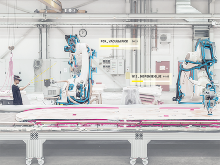Strategies for Human-Robot Collaboration in Building Prefabrication
A Case for Flexible, Task-oriented Augmented Reality Applications
Industrial prefabrication provides a highly relevant approach towards productivity and sustainability issues facing the construction industry. Timber construction especially benefits from prefabrication, for which many robotic technologies and advanced machineries have been developed. A critical yet under-addressed aspect is the role of skilled craft, which constitutes half a million workers across the timber construction and finishing sector in Germany. The expertise and flexible problem-solving abilities of craftspeople are particularly suited to the high adaptivity required by project-based construction SMEs, which play an essential role in the prefabrication of low batch sizes or one-off components typical for the AEC industry. The key question is: how to design for the integration of skilled craft within these ever more sophisticated digital fabrication systems?
This research sets out to explore the potentials of AR-enabled cyber-physical systems for multi-human-robot task sharing and collaboration in timber prefabrication. Augmented Reality (AR) blends virtual and physical objects to support users in decision making in-situ. AR extension of craft procedures has enabled novel constructions of complex, non-standard material systems; AR for inspection, maintenance, and manual assembly tasks has demonstrated many data integration, efficiency and ergonomic benefits. There is also a large body of work applying AR towards human-robot collaboration (HRC) in manufacturing and small-scale construction assemblies using collaborative robots.
The challenges for AR-based HRC in timber prefabrication are tackled with regards to three key aspects: 1) contextualising the approach within timber prefabrication-specific skilled craft, tasks, and processes; 2) addressing the need for heavy-payload robots to handle large-scale components; 3) fulfilling the flexible operation and project-based demands of timber construction SMEs. The proposed research hypothesises that an appropriate AR system can empower skilled workers within robotic systems and enhance prefabrication from both system- and human-centred perspectives. To validate this hypothesis, three research objectives are:
-
identify the potentials and benefits for HRC within timber building prefabrication;
-
develop a framework for the application and evaluation of task-oriented AR systems towards multi-actor task sharing and collaboration;
-
demonstrate the results of this approach through project-based experiments.
The anticipated outcomes of this research encompass methods related to AR system architecture (multi-user), algorithms (safety and worker pool) as well as appropriate design and evaluation measures for HRC in timber construction. The framework is concurrently developed and tested with a series of case studies while employing co-design methods in collaboration with industry partners and the Visualization Research Center (VISUS) at the University of Stuttgart. The research aims to demonstrate novel potentials of integrating skilled craft with advanced automation technologies through AR and contribute towards more socially and environmentally sustainable production practices in timber construction.
PROJECT TEAM
ICD Institute for Computational Design and Construction, University of Stuttgart
Xiliu Yang, Prof. Achim Menges
PROJECT FUNDING
BBSR Zukunft Bau (10.08.18.7-22.22)
Cluster of Excellence Integrative Computational Design and Construction for Architecture (IntCDC) (EXC 2120/1 RP 4)
RELATED PUBLICATIONS
Yang, X., Sousa Calepso, A., Amtsberg, A., Menges, A., Sedlmair, M. (2023). Usability Evaluation of an Augmented Reality System for Collaborative Fabrication between Multiple Humans and Industrial Robots. ACM Symposium of Spatial User Interaction 2023, Sydney, Australia. DOI: 10.1145/3607822.3614528.
Yang, X., Amtsberg, F., Skoury, L., Wagner, H., Menges, A. (2022). Vizor: Facilitating Cyber-physical Workflows in Prefabrication through Augmented Reality. 27th International Conference of the Association for Computer-Aided Architectural Design Research in Asia (CAADRIA 2022), Sydney, Australia. Forthcoming publication.
Contact Information

Xiliu Yang
M.Sc.Research Associate


